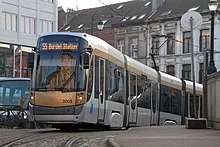Our website is made possible by displaying online advertisements to our visitors.
Please consider supporting us by disabling your ad blocker.
Trams in Brussels
This article needs additional citations for verification. (January 2024) |
Parts of this article (those related to "the multiple change to the network in connection with future metro line 3") need to be updated. (October 2024) |
| Brussels tramway network | |||||||||
|---|---|---|---|---|---|---|---|---|---|
 A Bombardier T3000 in Brussels, 2010 | |||||||||
| Operation | |||||||||
| Locale | Brussels, Belgium | ||||||||
| Routes | 18 (2019) | ||||||||
| Owner(s) | Brussels-Capital Region | ||||||||
| Operator(s) | STIB/MIVB | ||||||||
| Infrastructure | |||||||||
| Track gauge | 1,435 mm (4 ft 8+1⁄2 in) standard gauge | ||||||||
| Propulsion system(s) | Electricity | ||||||||
| Electrification | 750 V DC overhead lines | ||||||||
| Depot(s) | 7 | ||||||||
| Stock | 397 | ||||||||
| Statistics | |||||||||
| Track length (total) | 140.6 km | ||||||||
| Route length | 141.1 km (87.7 mi) | ||||||||
| 2017 | 149.1 million | ||||||||
| |||||||||
| |||||||||
| |||||||||
| |||||||||
| Website | http://www.mivb.be/index.htm?l=en STIB/MIVB (in English) | ||||||||
The Brussels tramway network is a tram system serving a large part of the Brussels-Capital Region of Belgium. It is the 16th largest tram system in the world by route length, in 2017 providing 149.1 million journeys (up 9.5% on 2016) over routes 140.6 km (87.4 mi) in length.[1] In 2018, it consisted of 18 tram lines (eight of which—lines 3, 4, 7, 25, 32, 51, 55 and 82—qualified as premetro lines, and five of which—lines 3, 4, 7, 8 and 9—qualified as "Chrono" or "Fast" lines). Brussels trams are operated by STIB/MIVB, the local public transport company.
The network's development has demonstrated many of the quandaries that face local public transport planners. It also has several interesting peculiarities: the inconsistent route pattern resulting from the closure of the interurban trams, the conflict between low-floor surface trams and high-floor underground trams, and whether the trams run on the right or the left.
- ^ Statistiques 2017 stib-mivb.be
Previous Page Next Page



